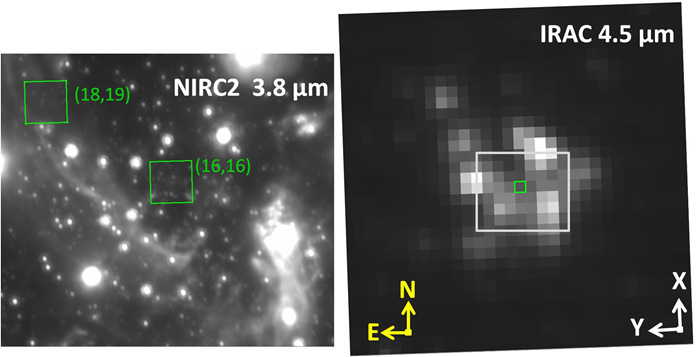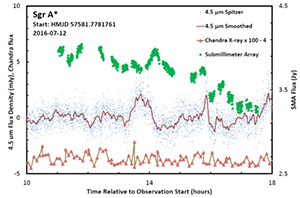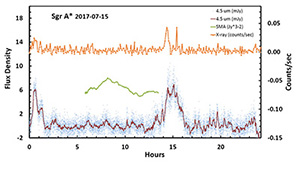Galactic Center: SgrA*:
SMA Participation in Simultaneous Monitoring of Flaring from the Galactic Center's
Supermassive Black Hole
The Galactic Center's supermassive black hole, Sgr A*, is a source of strong and fluctuating radiation emanating from the accretion flow. Since it lies about more than 100 times closer than any other SMBH, it is a prototype that can be studied in far greater detail than others.

Figure 1: IR images of the region around SgrA*. (left) Keck image 10"x9". (right) IRAC image of the region; grey box is the Keck field. Green squares correspond to one IRAC pixel (a reference pixel also shown).
We have been observing SgrA* variability with the SMA simultaneously with the Spitzer IRAC camera and the Chandra X-Ray Observatory; we also have simultaneous data with Keck. The process(es) responsible for variability are uncertain. Linear polarization in the radio, submm, and NIR suggests synchrotron emission at those wavelengths. X-ray emission could be direct synchrotron or some form of inverse Compton emission, but recent high-energy observations with NuSTAR favor direct synchrotron. Linear polarization has also been observed in submm flares. The temporal relationships between the submm and NIR/X-ray flares are important diagnostics: some models invoke evolution of the optical depth of the emitting medium leading to a wavelength-dependent delay. A powerful and unique advantage of the space-based observatories combined with SMA, therefore, is their ability to monitor the activity continuously for up to 24 hours, enabling long time-series analyses of the flaring character; it also helps makes it possible to correlate SMA flaring events with IR or even X-ray events. While X-ray and NIR flares have been roughly simultaneous, some initial observations found that the submm lags the NIR by ~90 minutes (Figure 2 left) suggesting a "plasma blob" that cools through expansion to lower the optical depth faster than synchrotron cooling alone. However, our 2014 campaign observed an event that peaked simultaneously. Our 2017 campaign (Figure 2 right) found a submm flare that preceded the IR/XR activity; the connection was reinforced the next day when neither the SMA nor Spitzer/Chandra saw any activity, suggesting that optically thin submm flares may indeed be present, and may even be prevalent. Answers should be forthcoming soon with a larger sample of simultaneous observations.
References:
Fazio, et al., Multiwavelength Light Curves of Two Remarkable Sagittarius A* Flares, submitted Ap.J., 2018
Boyce, H. et al., Simultaneous X-Ray and Infrared Observations Of Sagittarius A*'S Variability, submitted Ap.J., 2018
Witzel, G.; Martinez, G.; Hora, J.; Willner, S. P.; Morris, M. R.; Gammie, C.; Becklin, E. E.; Ashby, M. L. N.; Baganoff, F.; Carey, S.; Do, T.; Fazio, G. G.; Ghez, A.; Glaccum, W. J.; Haggard, D.; Herrero-Illana, R.; Ingalls, J.; Narayan, R.; Smith, H. A.,
Variability Timescale and Spectral Index of Sgr A* in the Near Infrared: Approximate Bayesian Computation Analysis of the Variability of the Closest Supermassive Black Hole, 2018, eprint arXiv:1806.00479


